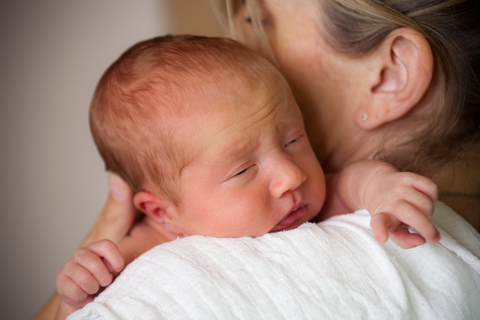
Newborn babies need a little help maintain their body temperatures in any season. Winter can mean cold winds and warm houses that leave it difficult for a baby to adjust. Be aware of your baby’s needs to help maintain a consistent body temperature.
Normal body temperature for a newborn baby is 97.5-99.ºF (36.5-37.ºC), about the same as your normal body temperature. Babies, though do not yet have the ability adults do to regulate their body temperature. They don’t have the insulation through layers of fat, and their large body surface area in relation to low body weight means more heat loss. You don’t need to pull out the thermometer every hour, though. Just feel the back of your baby’s neck for a quick temperature check.
We give babies a little extra help through clothing and coverings, adjusting room temperature, and keeping them close to us.
Around the House
All newborn babies need some help maintaining the right body temperature, but, if your baby had low birth weight, was born early, or is sick, take special care to monitor body temperature and keep your baby warm.
You are your baby’s best warmer. You can warm your baby through skin-to-skin contact, also called kangaroo care. Put your naked or diapered baby against your bare chest, then cover you both with a blanket. This is perfect for breastfeed. Even without kangaroo care, breastfeeding gives your baby warm milk and warm skin. Babywearing, whether just around the house or when you go out, also keeps you and your baby close.
Clothing. Choose clothing that allows the baby’s skin to breathe, using one more layer than you need. If you are in a T-shirt, add a light jacket or a footed suit in addition to a T-shirt. If you are wearing a sweater, you baby will need at least a sweater, too. Do not, however, layer your baby in too much clothing, causing overheating. If you are wearing your baby, count the wrap or sling as a layer. Don’t forget cold legs when pants ride up in the baby carrier. Baby legs or handknit socks will help.
Hat. Especially during the winter, your newborn will probably need to wear a hat, since babies lose heat through the head. Have lightweight cotton hats for indoors and a warmer, woolen hat for trips out.
Bath Time
Make sure the air and water temperature are comfortably warm without being hot. After the bath, dry the baby immediately. If the room temperature in your house is cool in the winter, you might want to opt for warm sponge baths for your baby. The most important step in keeping a newborn warm during bath time is drying off quickly to avoid heat lose through evaporation.
Nighttime
Your baby doesn’t need a blanket, not in the traditional sense of a large rectangular covering. Babies obviously can’t adjust their covers, so a blanket not only doesn’t stay put but could become a hazard. Your baby is better off wearing the blanket in the form of a worn sleeping bag for newborns or a footed sleeper suit as babies get older. Wool is perfect, since it breathes naturally and helps sleepers regulate their body temperature.
If your baby takes well to swaddling, this will also help maintain body temperature. Not all babies like being wrapped up so snuggly, but do try swaddling.
Going Out
Keeping your baby just the right temperature when it’s biting cold outside is tricky. Have a great insulted suit with legs, if you are going in the car. Although you baby will stay warmer with legs together and those newborn legs naturally want to curl up, you need legs separated for a car seat. If you are on foot and wearing your baby, a vest that covers you, your baby, and the baby carrier, like our Peekaru fleece vest, lets you keep your baby warm with your own body heat.
Be careful not to overheat your baby outside, though. Avoid direct sunlight, especially in the car, and don’t leave an insulated suit on for long drives in the car. Choose light layers of clothing that are easy to remove one by one as you move through your day and the temperature changes.
You are the perfect temperature to keep your baby warm but not too warm. Keep your newborn baby close this winter.
Resources
- Dr Tamara Keith, “Keeping Babies Warm,” July 5, 2012.
- World Health Organization (WHO), Thermal Protection of a Newborn, 1997.
Image © Kati Molin | Dreamstime.com
